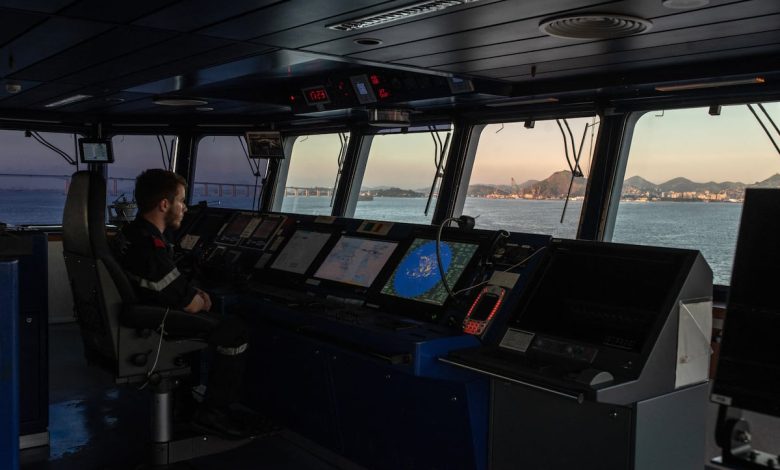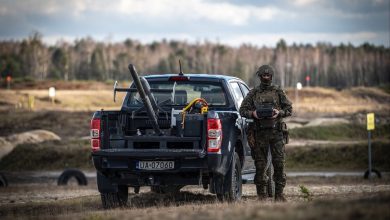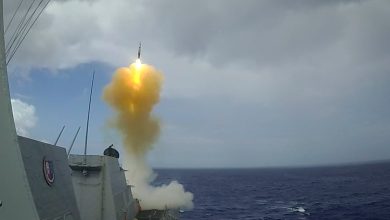French Navy tests unmanned beach assault, expands drone tactics

PARIS — The French Navy is stepping up drone use in the air and in the water, relying almost entirely on unmanned systems to recapture a beach in southern France in an amphibious operation during an exercise in March, according to the commander of the force.
In the exercise to retake a stretch of shore in the Bay of Hyères on France’s Mediterranean coast, the Navy used aerial drones and underwater gliders for maritime surveillance, drones to assault enemies targeting the beach, and to counterattack hostile drones, Navy Chief of Staff Adm. Nicolas Vaujour told a parliamentary hearing last week.
“We did it almost entirely with drones,” Vaujour told the National Assembly’s defense committee. “We are in the experimental phase to see exactly how far we want to go with each of these things.”
In the exercise called Dragoon Fury, the French Navy used its amphibious helicopter carrier Tonnerre as a drone platform. Vaujour said drones don’t fully replace amphibious maneuvers, and the Navy will still be dropping off troops and piloted military equipment on beaches, “but we are fully invested in this concept of drone carriers.”
Vaujour said the Navy is “starting to achieve some interesting things,” for example using first-person view drones or tele-operated munitions to take out attacking unmanned surface vehicles.
Despite these advancements, a drone force today isn’t able to provide the power projection of an aircraft carrier strike group, Vaujour told lawmakers. “Being able to drop six 125-kilogram bombs 400 to 600 nautical miles from the aircraft carrier, that’s something a drone can’t do.”
Drones are particularly well-suited for operations in confined areas such as the Baltic Sea, and can offer additional capabilities especially when operating near coastlines or a carrier platform, such as in the beach assault, said Vice Adm. Emmanuel Slaars, the French Navy commander in charge of operations, speaking after Vaujour. Still, don’t count on drones for all the solutions, he said.
“This is not high seas action, it is not the ability to fight against nuclear attack submarines,” Slaars told lawmakers. “We don’t yet have drones, either in the air or on the surface domain, capable of operating sustainably in contested environments – and I think it will still be a very long time before we do so in the surface domain.”
The Navy embarked around ten defense companies aboard the Tonnerre during Dragoon Fury in the first two weeks of March, to create a real-life laboratory for tactical and technological innovation. Participating companies included Alseamar with underwater gliders, Delair with several drones from its portfolio and Exail with its DriX H-8 unmanned surface vehicle.
The French Navy has been experimenting with autonomous underwater gliders for several years, with the systems truly operational “for some time now,” according to Vaujour. The Navy works with Alseamar, which makes a 2-meter long underwater glider called Seaexplorer with an advertised 1,700-kilometer range and 110-day endurance.
During last year’s Polaris 24 exercise, in which the French and Italian navies faced off in the Mediterranean, the French force deployed gliders that were able to detect a number of Italian vessels. The French then struck the opposing ships with carrier aircraft from “a very, very long way off,” leaving the Italians clueless to how they’d been localized, according to Vaujour.
Locating the opposing vessels relied on “lots of artificial intelligence” to detect small signals in the data collected by the gliders, according to the admiral.
“So that was quite an interesting breakthrough that shows there’s a place for gliders,” Vaujour said. “On the other hand, with passive detection alone, you can’t detect everything.”
Gliders are “still a long way off” from being able to sniff out a nuclear-powered ballistic missile submarine, according to Vaujour. However, they will have their place in maritime surveillance, and passive swarms combined with artificial intelligence for data analysis are an interesting means of detection, he said.
“There’s still a lot of room for improvement,” the admiral said. “We’re developing these tools on a national level, with real capabilities, but also real limitations. The manufacturer who says they’re going to make the oceans transparent isn’t credible yet, let’s say.”
AI hasn’t yet been able to replace the human ear for analysis of acoustic signals, “even though a lot of money has been spent trying to do so,” Vaujour said. What the Navy needs are acoustic warfare analysts that understand the technology and “who will help the AI to help them,” he said.
The Navy is taking an “iterative approach” to AI development, bringing aboard experts so they can see what the force needs, according to Vaujour.
The Navy’s center for data services and AI developed an onboard data hub that was tested onboard the frigate Provence, with Vaujour describing the hub as “a huge computer” collecting all data from a ship, with subsequent analysis catching signals that would previously have gone unnoticed.
The success of the test prompted the Navy to put four data hubs on ships taking part in a five-month deployment of the Charles de Gaulle aircraft carrier strike group, from late November to late April. The Navy also invited data scientists from French defense firms along for a month-long stint during the mission.
Vaujour gave lawmakers a non-classified example of AI use on the Provence, in which algorithms tracked down the underlying cause of a diesel alternator valve failure, identifying a rising fluid temperature elsewhere in the system as the culprit.
In another example, before passing a strait in Indonesia during the Charles de Gaulle deployment, the Navy used AI to analyze hundreds of possible locations for a Chinese submarine to work out the best tactical screen for the carrier, which Vaujour said “wasn’t entirely intuitive.”
The Navy now needs to build up its AI skills, which must become generalized, and structure how the subject is approached from a human-resources angle, Vaujour said in the committee hearing.
“How do we inject artificial intelligence modules into all naval training, not to turn people into data scientists, but to create maritime experts in a field who can easily plug into artificial intelligence,” Vaujour said. “I’m not going to turn data scientists into acoustic experts. However, I can make acoustic experts compatible with data scientists. That’s the direction we’re headed.”
Rudy Ruitenberg is a Europe correspondent for Defense News. He started his career at Bloomberg News and has experience reporting on technology, commodity markets and politics.







